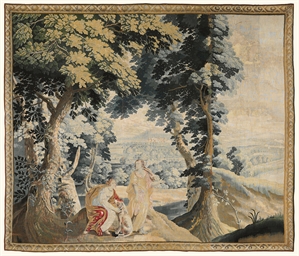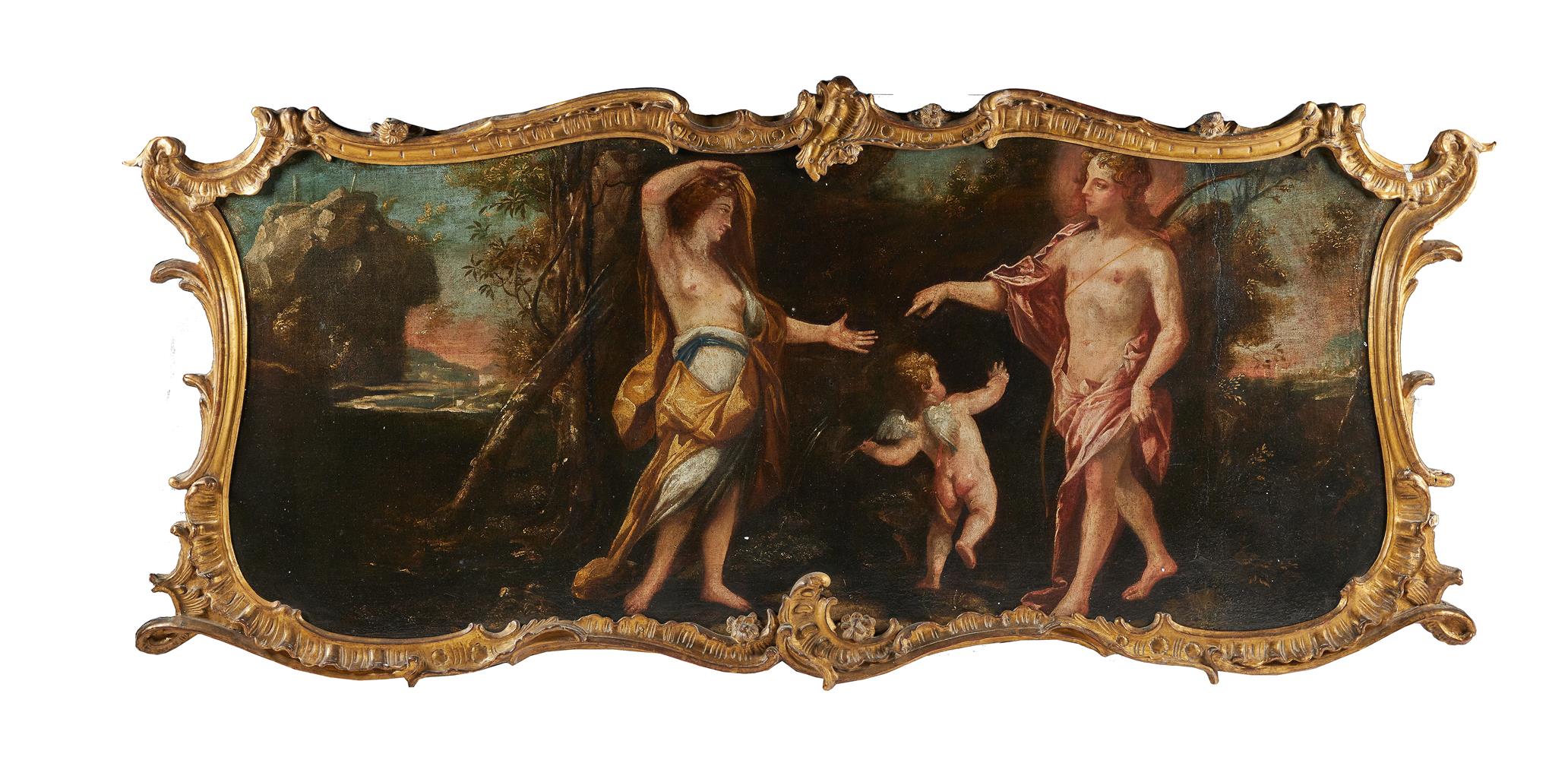Ovid, Metamorphoses, with an account of a witchs potion to raise a man from the dead, and mentioning a werewolfs power to change its wild-beast features into a mans, in Latin verse in dactylic hexameter, decorated manuscript on parchment [probably Low Countries, fourteenth century] Bifolium, each leaf with 32 lines in a professional squat early gothic bookhand (and text continuous across all pages here, and thus this most probably the centremost bifolium of a gathering; note one line here dissimilemque animam subiit Aeta relictus (with last word here miscopied as relicta) should be VII:170 but it appears here out of order between lines 293-4, capitals in spiky penstrokes touched with vermillion red, these set in margin in keeping with medieval practise of writing verse, each line marked in outer margin with a penwork punctus or punctus flexus, paragraph marks in same red, numerous contemporary or near-contemporary interlinear and marginal additions with alternative readings, reused on the later medieval binding of a sixteenth-century account book, and so with tears to edges, scuffs, stains, small holes, occasional later scrawls and somewhat darkened on reverse, each leaf: 225 by 149mm. This is Ovids greatest and longest work, spanning nearly 12,000 lines and narrating the history of the world from Creation until the deification of Julius Caesar In doing so it surveys over 250 Greek myths, and has come to be a principal source for many of those. It had a profound impact on later writers, and is among the fundamental cornerstones of much Ancient, medieval and modern literature. The readings here are from book VII, lines 225-347, which discuss the events after Jasons acquisition of the Golden Fleece, that is Medeas travels on her dragon-drawn flying carriage to collect herbs to raise Aeson back to life in her secret gore-soaked rites. This magical spell contains a list of ingredients as captivating as it is macabre: she combines these herbs with stones from the Orient, ocean sands, hoar frost gathered under a full moon, the wings and flesh of a screech-owl, and inque virum soliti vultus mutare ferinos ambigui prosecta lupi (the entrails of a werewolf which has the power of changing its wild-beast features into a mans), the skin of the Cinyphan water snake, the liver of a long-lived stag and the eggs and head of a crow nine generations old. She then cuts the old mans throat and replaces his blood with the resulting brew, restoring him to his youth. Belief in werewolves, or lycanthropes, seems to have been commonplace in Greek and Roman mythology, with Herodotus identifying the tribe of the Neuri as changing into wolves for one day a year, and the Greek geographer Pausanias describing this affliction as affecting Lycaon in punishment for his murder of a child. Other than Ovid, Roman writers such as Livy and Pliny the elder relate stories of men who were bound to change into wolves, but the idea was not common in the Middle Ages before the fourteenth century when the study of witnesses such as this appears to have combined with Germanic legends about the shapeshifting activities of witches and vampires.
Ovid, Metamorphoses, with an account of a witchs potion to raise a man from the dead, and mentioning a werewolfs power to change its wild-beast features into a mans, in Latin verse in dactylic hexameter, decorated manuscript on parchment [probably Low Countries, fourteenth century] Bifolium, each leaf with 32 lines in a professional squat early gothic bookhand (and text continuous across all pages here, and thus this most probably the centremost bifolium of a gathering; note one line here dissimilemque animam subiit Aeta relictus (with last word here miscopied as relicta) should be VII:170 but it appears here out of order between lines 293-4, capitals in spiky penstrokes touched with vermillion red, these set in margin in keeping with medieval practise of writing verse, each line marked in outer margin with a penwork punctus or punctus flexus, paragraph marks in same red, numerous contemporary or near-contemporary interlinear and marginal additions with alternative readings, reused on the later medieval binding of a sixteenth-century account book, and so with tears to edges, scuffs, stains, small holes, occasional later scrawls and somewhat darkened on reverse, each leaf: 225 by 149mm. This is Ovids greatest and longest work, spanning nearly 12,000 lines and narrating the history of the world from Creation until the deification of Julius Caesar In doing so it surveys over 250 Greek myths, and has come to be a principal source for many of those. It had a profound impact on later writers, and is among the fundamental cornerstones of much Ancient, medieval and modern literature. The readings here are from book VII, lines 225-347, which discuss the events after Jasons acquisition of the Golden Fleece, that is Medeas travels on her dragon-drawn flying carriage to collect herbs to raise Aeson back to life in her secret gore-soaked rites. This magical spell contains a list of ingredients as captivating as it is macabre: she combines these herbs with stones from the Orient, ocean sands, hoar frost gathered under a full moon, the wings and flesh of a screech-owl, and inque virum soliti vultus mutare ferinos ambigui prosecta lupi (the entrails of a werewolf which has the power of changing its wild-beast features into a mans), the skin of the Cinyphan water snake, the liver of a long-lived stag and the eggs and head of a crow nine generations old. She then cuts the old mans throat and replaces his blood with the resulting brew, restoring him to his youth. Belief in werewolves, or lycanthropes, seems to have been commonplace in Greek and Roman mythology, with Herodotus identifying the tribe of the Neuri as changing into wolves for one day a year, and the Greek geographer Pausanias describing this affliction as affecting Lycaon in punishment for his murder of a child. Other than Ovid, Roman writers such as Livy and Pliny the elder relate stories of men who were bound to change into wolves, but the idea was not common in the Middle Ages before the fourteenth century when the study of witnesses such as this appears to have combined with Germanic legends about the shapeshifting activities of witches and vampires.













.jpg)
Testen Sie LotSearch und seine Premium-Features 7 Tage - ohne Kosten!
Lassen Sie sich automatisch über neue Objekte in kommenden Auktionen benachrichtigen.
Suchauftrag anlegen